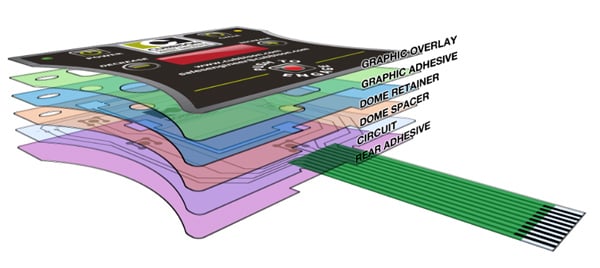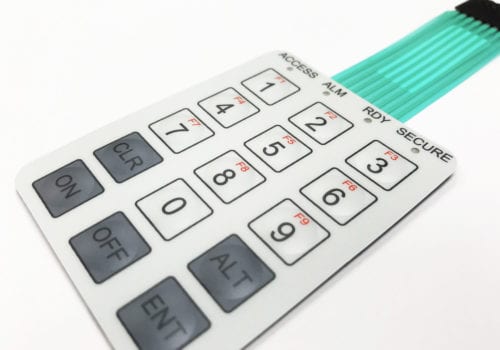Why Membrane Switches Are Critical for Efficient Control in Healthcare Devices
Why Membrane Switches Are Critical for Efficient Control in Healthcare Devices
Blog Article
Membrane Switch Over Innovation: The Secret to Dependable and Economical User Interfaces
Membrane layer button technology has arised as a crucial part in the layout of individual interfaces, supplying both reliability and cost-effectiveness across a diverse variety of applications. As we check out the multifaceted benefits of membrane switches, their potential for technology raises questions about future applications and advancing trends.
Comprehending Membrane Switch Over Innovation
Membrane layer button technology is a commonly made use of interface option in numerous electronic devices, providing a seamless blend of capability and layout. This technology integrates numerous layers of materials, typically containing a graphic overlay, spacer layer, and a circuit layer. The visuals overlay displays the interface elements, while the spacer layer separates the circuit layer from the overlay until a customer turns on a switch.
When pressure is used to the overlay, the circuit layer finishes the electrical circuit, sending a signal to the gadget. This system permits different configurations, including tactile feedback and backlighting choices, improving user communication. Membrane switches are usually made utilizing durable materials such as polyester or polycarbonate, guaranteeing durability and resistance to ecological aspects like dampness and dust.
The adaptability of membrane layer switches allows their application in varied industries, including clinical devices, customer electronic devices, and industrial controls. Their compact design enables combination into space-constrained settings, providing an effective individual interface without compromising aesthetic appeal. Understanding the intricacies of membrane button innovation is important for suppliers and designers looking for to create reputable and reliable human-machine interfaces.
Key Advantages of Membrane Layer Switches
While various interface options exist, membrane changes deal unique advantages that make them a favored option in many applications. One of the main benefits is their durability; membrane layer buttons are created to endure extreme ecological problems, including wetness, dust, and temperature level changes, making certain lasting performance. This durability considerably reduces the demand for constant substitutes, thus lowering general maintenance prices.

Additionally, membrane switches are light-weight and compact, making them appropriate for applications where space is restricted. Their inconspicuous layout adds to a smooth appearance without endangering performance.
Cost-effectiveness is likewise a noteworthy advantage, as the manufacturing procedure for membrane layer switches over tends to be cheaper contrasted to typical mechanical buttons. This cost, combined with their dependability and ease of installation, settings membrane changes as a functional solution for a broad range of industries looking for efficient and efficient interface.
Applications Across Various Industries
How do membrane buttons adapt to the diverse requirements of various sectors? Membrane layer switch modern technology is progressively recognized for its adaptability, making it ideal for a large range of applications across several sectors.
In customer electronic devices, membrane switches give a portable option for push-button controls and home devices, improving individual experience via intuitive style. Additionally, the industrial field leverages membrane buttons for equipment control panels, gaining from their resistance to harsh environments, such as dampness and dirt.
Army and aerospace applications also use membrane layer switches for their reliability and capacity to withstand severe conditions, making sure functional performance in critical circumstances. The food and drink sector takes on these switches for go to this web-site automated systems, where sanitation and convenience of operation are extremely important (membrane switch). Ultimately, membrane buttons are customized to satisfy the unique needs of each market, confirming their important role in modern-day innovation user interfaces
Design and Personalization Options

In the realm of membrane layer button technology, design and customization options play a crucial duty in enhancing functionality and individual interaction. These buttons can be customized to meet particular operational needs and visual choices, making them versatile components in numerous applications.
Among the key modification choices is the format of the switch itself, which can be developed to accommodate special user interfaces and ergonomic considerations. By changing the shape, size, and plan of buttons, makers can develop user-friendly layouts that facilitate simplicity of use. Furthermore, the incorporation of different shades and graphic overlays enables branding and improved visibility, making sure that individuals can swiftly recognize functions.
In addition, membrane layer buttons can be engineered with different responsive feedback devices, such as increased switches or distinct clicks, to enhance the user experience. Various materials can also be chosen for durability and environmental resistance, addressing elements such as wetness, temperature changes, and chemical direct exposure.
Inevitably, the substantial style and modification choices available in membrane button technology empower companies to create customized remedies that not just fulfill practical requirements yet additionally line up with their branding and functional demands.

Future Patterns in Membrane Layer Buttons
As membrane switch modern technology remains to advance, future patterns are significantly concentrated on enhancing individual experience and integrating advanced capabilities. One considerable pattern is the assimilation of touch-sensitive and capacitive modern technologies right into conventional membrane layer switches. This development enables even more intuitive interface, giving responsive feedback while maintaining a streamlined style.
One more emerging pattern is making use of eco-friendly materials, driven by the expanding need for lasting manufacturing methods. Suppliers are looking for to lower their carbon footprint by utilizing recyclable substrates and low-impact inks, lining up with international sustainability goals.
Additionally, the rise of the Web of Points (IoT) is triggering the unification of wise functions into membrane layer buttons. Enhanced connection alternatives will allow gadgets to communicate with each various other, permitting for smooth integration right into broader systems.
Furthermore, improvements in printing technologies, such look at this site as electronic printing, are permitting get redirected here greater layout adaptability and personalization. This enables producers to produce detailed styles and vivid colors cost-effectively.

Conclusion
In conclusion, membrane layer button modern technology stands for a vital development in user interface style, offering considerable advantages in resilience, customization, and cost-effectiveness. As improvements proceed to emerge, especially in touch-sensitive interfaces and sustainable materials, the capacity for membrane layer changes to enhance individual experience and functionality remains encouraging.
Report this page